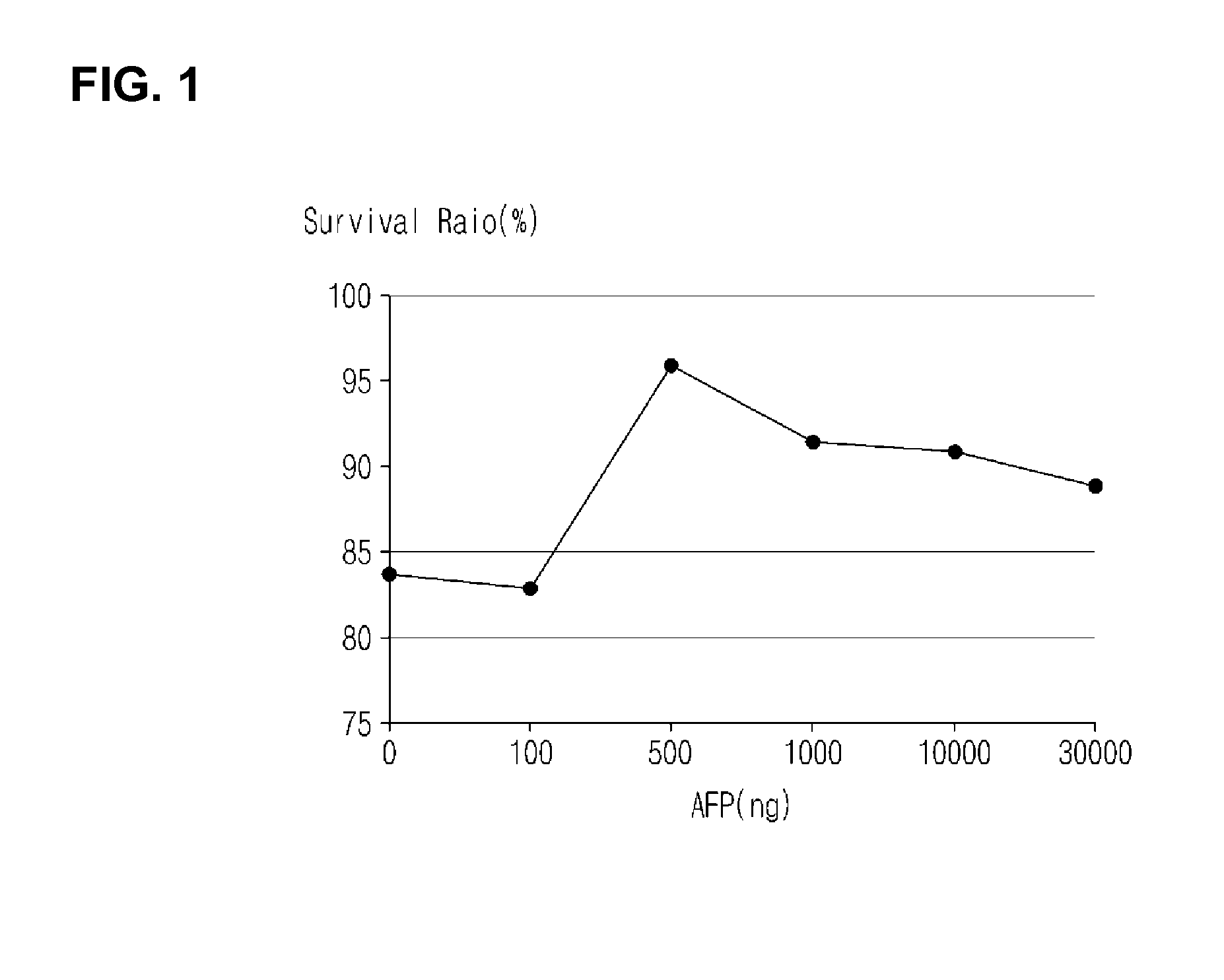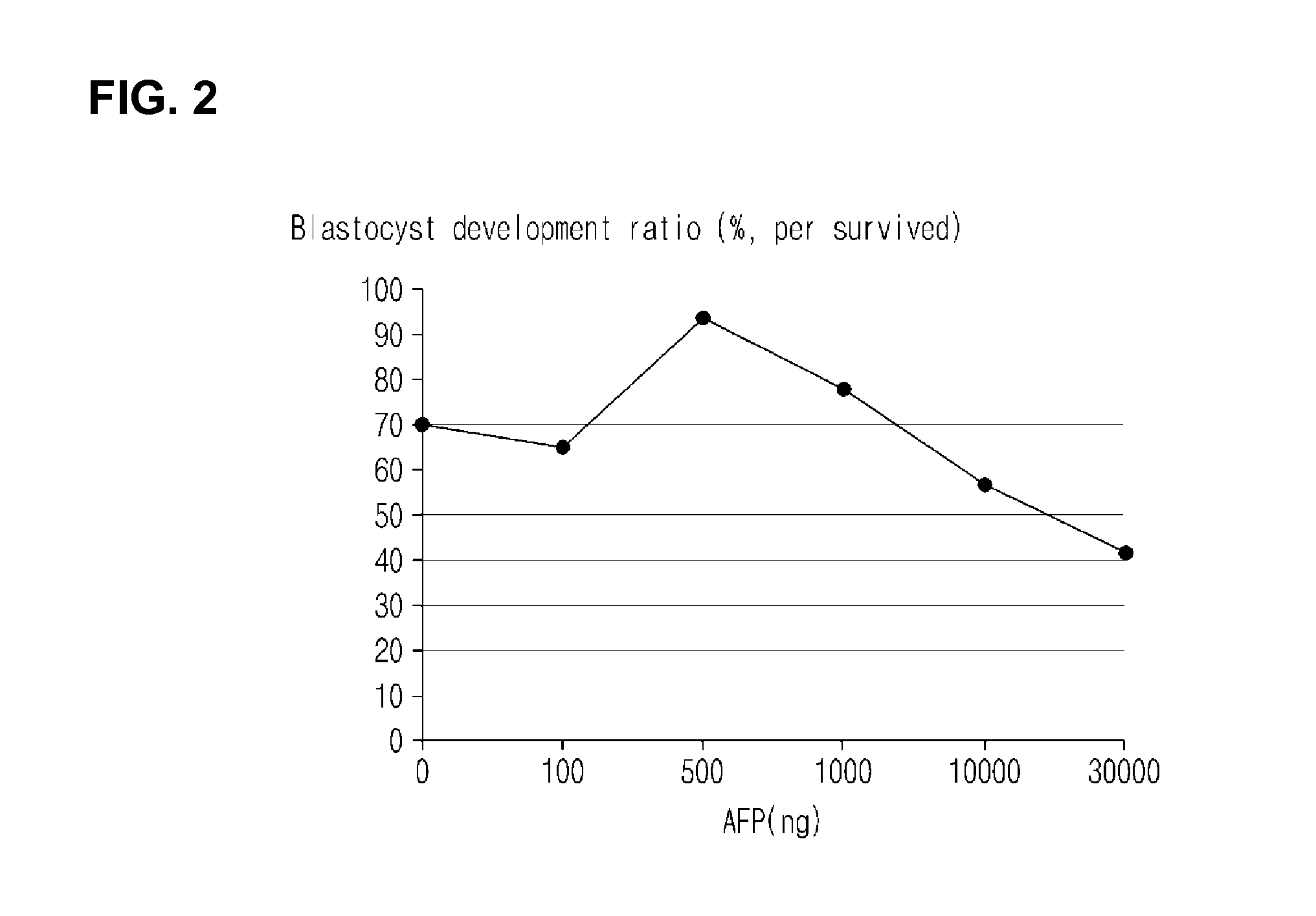Method of oocyte cryopreservation using antifreeze protein
a cryopreservation method and antifreeze technology, applied in the field of oocyte cryopreservation using antifreeze protein, can solve the problems of low success rate of freezing treatment of oocytes, large amount of moisture, and damage to frozen oocytes, so as to improve the survival rate of oocytes, improve the fertilization rate, and minimize the damage of oocytes
- Summary
- Abstract
- Description
- Claims
- Application Information
AI Technical Summary
Benefits of technology
Problems solved by technology
Method used
Image
Examples
example 1
Oocyte Cryopreservation Through Addition of an Antifreeze Protein
[0024]An oocyte was suspended in 20 vol % fetal bovine serum (FBS) solution in HEPES-buffered TCM-199 (Gibco) as a basic medium for 5 minutes, and was separated. 20 ml of equilibrium solution (ES) containing 7.5 vol % ethylene glycol (1.5 ml), 7.5 vol % propylene glycol (1.5 ml) and basic medium 17 ml was prepared. The separated oocyte was suspended in 700 μl of equilibrium solution for 5 minutes. Then, the oocyte was separated again. A vitrification solution (VS) containing 15 vol % ethylene glycol (3 ml), 15 vol % propylene glycol (3 ml), 0.5M sucrose (3.424 g / 20 ml) and basic medium 14 ml was prepared. The separated oocyte was suspended in 700 μl of vitrification solution for less than 1 minute. 5 to 6 oocytes on the vitrification solution (VS) were replaced on CryoTop (Kitazato, Japan), and their moisture was removed. Immediately, they were immersed within liquid nitrogen and stored in a nitrogen tank. Herein, each...
example 2
Cryopreservation of Oocyte According to the Weight Ratio of an Antifreeze Protein
[0027]Antifreeze protein was added in different weight ratios of 100 ng / ml, 500 ng / ml, 1 μg / ml, 10 μg / ml and 30 / ml, a survival rate, a fertilization rate, and a blastocyst development ratio of an In-vivo matured MII oocyte were measured according to the weight ratio of the antifreeze protein. This experiment was carried out in the same manner as described in Example 1 except that the weight ratios of the antifreeze protein were varied.
[0028]As a result, when the antifreeze protein was added at a weight ratio of 500 ng / ml, oocyte showed very significant good results in a survival rate, a maturity rate, a fertilization rate (cleavage rate), and a blastocyst development ratio (see FIGS. 1 and 2). From this, it was identified that a specific weight ratio of an added antifreeze protein is an important factor in determining the survival rate, the maturity rate, the fertilization rate, and the blastocyst devel...
example 3
Formation of Spindle Fibers and Separation of Chromosomes According to Addition of an Antifreeze Protein
[0029]After an In-vivo matured oocyte was vitrified with addition of an antifreeze protein at a ratio of 500 ng / ml, the formation of spindle fibers and the separation of chromosomes were observed. As a result, it was found that the number of oocytes maintaining their normal status was increased (Table 4).
[0030]A normal status and an abnormal status of spindle fibers were discriminated as follows. In normal spindle fibers, a nucleus is lined up with respect to an equatorial plate, and the spindle fibers are symmetrically disposed in a spindle form with respect to the nucleus. In abnormal spindle fibers, a nucleus is lost or disposed in a loose order without being lined up, or some of spindle fiber are lost or tangled and lumped together. The normal status is graded as follows. Grade 1 of a normal status indicates that the form is partially similar or very similar to that before fre...
PUM
| Property | Measurement | Unit |
|---|---|---|
| vol % | aaaaa | aaaaa |
| vol % | aaaaa | aaaaa |
| concentration | aaaaa | aaaaa |
Abstract
Description
Claims
Application Information
 Login to View More
Login to View More - R&D
- Intellectual Property
- Life Sciences
- Materials
- Tech Scout
- Unparalleled Data Quality
- Higher Quality Content
- 60% Fewer Hallucinations
Browse by: Latest US Patents, China's latest patents, Technical Efficacy Thesaurus, Application Domain, Technology Topic, Popular Technical Reports.
© 2025 PatSnap. All rights reserved.Legal|Privacy policy|Modern Slavery Act Transparency Statement|Sitemap|About US| Contact US: help@patsnap.com


